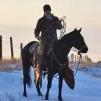
horsewreck
Members-
Posts
209 -
Joined
-
Last visited
About horsewreck
- Birthday February 2
Profile Information
-
Gender
Male
-
Location
south central Texas
-
Interests
Family, working, and all things cowboy....
LW Info
-
Leatherwork Specialty
Saddlery, Gun Leather, Case Goods.
-
Interested in learning about
most areas of working with veg. leather
Recent Profile Visitors
12,286 profile views
horsewreck's Achievements

Member (2/4)
-
Looking for 4 and or 8 stitch per inch marker wheels. I have several handles but need wheels.. Could also use complete handles with fixed wheels in 4 and or 8 stitches per inch..
-
Kodel is the cheap stuff, cheap in many ways. If you don't want to use wool barks (the real thing) try to find 100% wool on a synthetic backer. Weaver stocks all manner of these type products. As for glues you can't use saddle paste or any of the other water based products as they will migrate through the backer and can mess you up good. Contact cement works well but can be a real pain if you have to remove it at a later date.. I hope this helps..
-
I remember this from way back, all in all good advise ..
-
Oltoot has it about right. Back in the day, makers of 3/4 and 7/8 riggings would run the stirrup leather up over the tree then down through ring on the rigging. This did bind the stirrup in a forward position. If one rode a lot of open flat country this could feel comfortable to the rider. In hills and mountains this setup made riding difficult. By the early 1940's the practice of running leathers through the rigging was being abandon in favor of the free swinging style with both pieces passing in front of the rigging.
-
Have not tried any of the rawhide lace you mentioned, but I used to get great rawhide lace from Tejas Industries in Amarillo TX. I have not bought from them in three or four years, but they always seemed to be able to supply anything I needed, (Width, thickness,) ..
-
Question Posed To Professional Leather Artisans.
horsewreck replied to mrbeebs23's topic in Leatherwork Conversation
Skills needed to do one type of work do transfer to other specialties, and trying make a go of it doing a very limited number of products can limit you chances of success. First we need to look at what people want (need) and what is available to them. We operate a full time leather business and didn't set out to do a particular products. After years of doing saddlery and general leather work on the side my wife and I went into it full time. We thought we could just build a few custom saddles and tack and make a go of it. I prefer to do new work rather than repairs, however by being willing to do saddle repairs our business was able to succeed beyond our hopes. Today we do a booming repair business, as well as a volume of new gun leather, case and strap goods, tack and new saddles. I now think that had I only been willing to do say new saddles, I would have perished in this business. That is not to say a person can't make it doing only one thing and doing it well, they can. I know an individual who specialize in luggage, another who does only gun leather and they do fine. Long story short develop your skills, find out what you like to do, be flexible, and figure out what products are wanted by the customer, and you will be successful. It is easier to fill a need than it is to create a demand..- 8 replies
-
- leather
- leather artisan
-
(and 3 more)
Tagged with:
-
It appears to be the same saddle as the Bona Allen you found. Bruce is correct in that most Porter Saddles of that era are stamped in multiple locations. We have had several Porter saddles in the shop over the years and they all seem to have been well marked. You surely have a Bona Allen.. Give it a good cleaning with any major brand of saddle soap and a coat or two of Lexol, Rudys by Bee Natural, or any good quality sadle oil.. Those oldies are a joy to look at, enjoy.. Jeff
-
Mink Oil
horsewreck replied to Curley Fryes's topic in Dyes, Antiques, Stains, Glues, Waxes, Finishes and Conditioners.
Mato, Olive oil has been used on leather for a long time, it yields a rich color when applied to new leather. Some old timers even used unsalted butter on their saddles. Jeff -
Mink Oil
horsewreck replied to Curley Fryes's topic in Dyes, Antiques, Stains, Glues, Waxes, Finishes and Conditioners.
Vikti: Using mink oil will not make leather any softer than most other oils, nor will it make leather brittle, or water proof. Most waterproofing is done by sealing the surface of leather for example waxes will make leather more water proof. Jeff -
Mink Oil
horsewreck replied to Curley Fryes's topic in Dyes, Antiques, Stains, Glues, Waxes, Finishes and Conditioners.
If you already have the mink oil it will do fine on most of your work. We use mostly 100% pure neatsfoot, and extra virgin olive oil in the shop, but also use lexol, Montana Pitch Blend oil (which contains mink oil) and others from time to time to get the desired effect on our leather. When you have more than one type of oil take a scrap of leather and apply the different oils to small areas and compare the different color tones that result. Most people have a favorite oil but many will keep several types on hand for different looks. At one time or another folks have used just about all types of animal and veg. oils on leather. I hope this is of some help to you.. Jeff -
Luberto Classic And Luberto No 7
horsewreck replied to Singermania's topic in Leather Sewing Machines
Steve, I don't know anything about what has happened to Luberto's web sight or the company for that matter. As far as the Classic machine goes I can only tell you we have been running one in our shop about seven years and have never had any problems with it. We bought the machine new and found it to be trouble free period! It is easy to run, and goes at a nice slow pace. As far as I know the No.9 is the same square drive, needle feed, jump foot machine as the Classic. The basic design of these machines have been around forever, the classic is just the latest version of the design. If you are interested in the Classic machine, I would say you will be lucky to find a lightly used one as people don't seem to part with them. I hope this is of some help to you.. Jeff -
Stretching replacement stirrup leathers before they are mated to the fender is very important to do on new stirrup leathers, even on older saddles. If this is not done the new leather will stretch and put an excessive amount of weight on older fender leather,which will result in ripping at the fender leg. In our shop we cut a piece of leather 6 1/4 inches wide, wet it, when it's ready we clamp both ends of the strap down and block up the center until it won't stretch any more. We leave it to dry out good, then we cut that strap down into two 3" straps, the leather is also slicked. after leathers have been install on the fenders and placed on the saddle we wet and set the turn in them. We do all stirrup leathers this way on both new saddles and replacement leathers.
-
If you plan on making many belts you might consider buying a double back, side, or other large piece of leather from Weaver. They offer a strap cutting service and for a fee of $8.70 will make the entire piece into say 1 1/2" straps. We use this service in our shop and it is a real time saver.
-
I think this is a great topic, let's see where it leads. I think aggiebraider ment to say "if you use 3inch leathers you might consider 2 1/2 inch instead" which I'm sure you know are most often used on cutters,racers, and performance saddles. When you make full leathers the stirrup leather does hang in a straight line without regard to fender shape or top attachment point. When you make 1/2 leathers the fender becomes part of the loop so to speak, and the concept of forward cut fenders become more useful because you can not only offset the point of attachment at the fender top but also the angle of attachment, something you can't do with full leathers. Placement of the stirrup leather groove in trees has so much to do with how the stirrup sits and moves and is the starting point of what you end up with. If you use production trees you might not have much input, but if you custom order trees you can discuss the ultimate use of the saddle with the tree maker and get the groove set accordingly. Nothing makes for a longer ride than spending all it in a saddle that was designed for a quick team roping run... Jeff
-
Your right it is vol. 2 my mistake... Jeff


.thumb.jpg.deab938f53c92606f993c3d740aee2ef.jpg)

